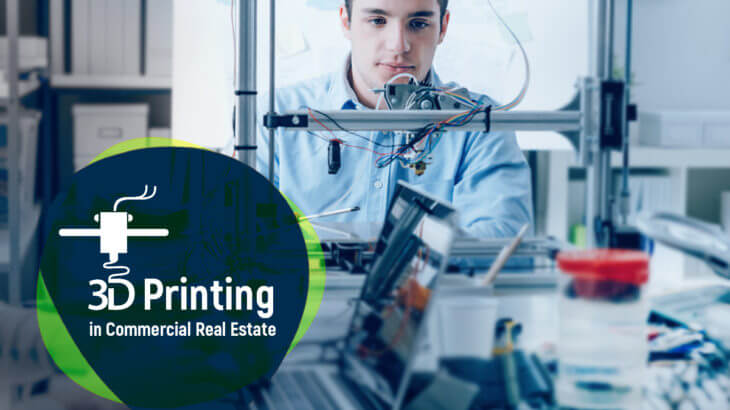3D printing:
To put it simply, 3D printing is the technique of creating physical objects from digital data (ideas/designs), often in a matter of hours. 3D printing is also referred to as Additive Manufacturing because the process involves creating an object layer by layer….saving cost, time, material and effort. The object can be anything from a car, toys, medical devices, airplanes, organs of the body to buildings. 3D printing also allows us to redesign apart instead of the whole object, making the process of re-design far more nimble than it ever has been.
Implications of 3D printing on commercial real estate:
Apart from the obvious savings in time, 3D printing is driving operational efficiency by creating objects on demand, minimizing the need for storage centers. It has the potential to reduce construction time by 50-70%, reduce material cost by least 40-60%, and reduce labor costs by 50-80%. Large 3D printers are even making construction of vertical structures possible. Another benefit of 3D printing is that it has a higher sustainability footprint, as environmental friendly material including recycled waste can be used to create material that not only is of a better construction quality but also sturdy, withstanding as much as an earthquake with an intensity of magnitude 8 on the Richter scale. In fact, architects in Netherlands are using 3D printing's building mixture with 80% plant oil strengthened with microfibers. Can it get any greener?
Current situation:
Adoption of this technology has been a little slow. In France, in a children's playground, 3D printed components have been used, but its more from an aesthetic value than a functional one. In the US, it could take longer to implement as safety standards and building codes must be adapted for 3D printed materials.
We expect to see 3D printing adopted in a phased manner, with an increasing number of building components created on site. The technology has already outpaced building codes and regulations, which will need to catch up in order for the benefits of 3D printing to be fully realized.
Retail and supply chain:
3D printing will affect supply chain too. E-commerce giant Amazon is trying same-day deliveries for their customers. With 3D printing, products can actually be created on demand. With less space needed for warehousing, distribution centers can be smaller allowing them to be located closer to large population areas. 3D printing should find its way to retailers too, with in-store manufacturing disrupting the traditional retailer model. This is likely to impact inventory management, where no raw material will be required till an order comes through, hence costs will be incurred only while transporting raw material (when required). For eg. Lowe, a home improvement and appliances retailer create customized products and ships directly to the customer location. Macy's also creates 3D printed personalized products ranging from jewelry to jeans.
Examples:
China was the first to attempt 3D printing of buildings - WinSun building - a 5 storey 3D printed apartment was created with 1 floor completed per day and at a cost of just USD160,000. This was chiefly due to walls that were printed in a zig-zag pattern which provided insulation due to reinforcement. When the printed pieces were connected, insulation and steel reinforcements were attached, thereby adhering to the existing building standards. WinSun also developed ten 3D printed houses in 24 hrs (2014), made of a mixture which was similar to cement. Dubai boasts of the first ever 3D printed office which uses 3D printing technology in full scale by printing it in 17 days. The Dubai building used a 20-foot-tall printer with a 120-foot-long robotic arm for construction. Dubai intends to build 25% of its buildings and also create furniture using 3D printing technology by 2030. Engineer Alex Le Roux, a graduate student at Baylor University has built a small house using 3D printing in just 24 hours. The World’s Advanced Saving Project (WASP) began creating homes through 3D printing resulting in a village called a “technological village.” Chinese (Beijing) firm Huashang Tengda created a 4305 sq ft. house in just 45 days in 2016. The Philippines built emergency houses after the destruction caused by Typhoon Haiyan in 2013.
While 3D printing was discovered way back in 1984, it is only now that it is coming into its own. It is emerging as one of the most fascinating and disruptive technologies of all time, with its full potential yet to be realized. The onus now lies on CRE owners to rethink their strategy and act, rather than react, to the transformation that is being brought about to the built environment.
